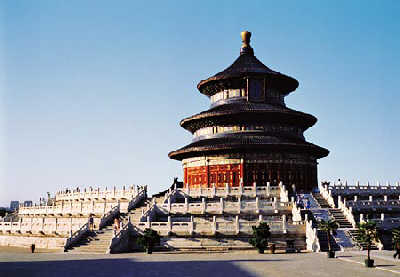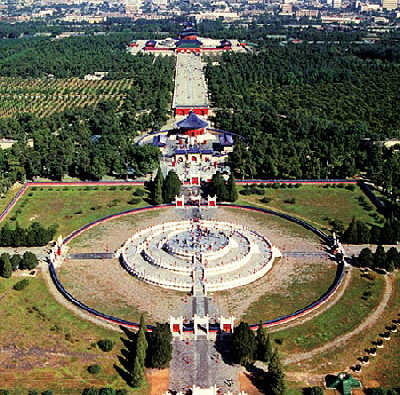

The Temple of Heaven is located on the east side of the front gate in the south city of Beijing. It is the place where emperors of the Ming and Qing dynasties worshipped and was built in the 18th year (1420) of the reign of Ming Emperor ChengZu. Thealtar, in a plane round shape, called Huanqiu Hill, was rebuilt in the 17th year (1752) of Qing Emperor Gaozong. Qiniandian (Hall of Prayer for Good Harvests) was rebuilt in the 16th year (1890) of Emperor Dezong.
The Temple of Heaven is very large in area, stretching 1,700 meters from east to west and 1,600 meters from north to south, with two circles of enclosing walls. The southern side had square corner and the north side round ones, symbolizing the place of a round heaven. Walking eastward from the front (west) gate, within the inner wall there is a zhaigong (fasting-palace) in the south for the emperor to fast and bathe before worshipping. Further east is a north-south vertical axis formed by the main buildings. Huanqiu is in the south with a three-layered stone terrace. Within the Beiyuan courtyard of Huanqiu is a round hall, or the imperial vault where the spirit tablet of the heavenly god is placed. Going further north, one can reach the Qiniandian Hall via Danbiqiao Bridge.
The Temple of Heaven uses ecological artistic technique to give prominence to the theme of "heaven". For example, the density of structures is very small, covered by large tracts of pine and cypress trees, creating a strong atmosphere of solemnity and nobility The inner walls are not in the middle of the area enclosed by the outer walls, but rather they shift toward the east, the vertical axis of the cluster of buildings also shifts eastward for about 200 meters, thus prolonging the distance from the front gate.

Copyright ©1999-2011 Chinanews.com. All rights reserved.
Reproduction in whole or in part without permission is prohibited.